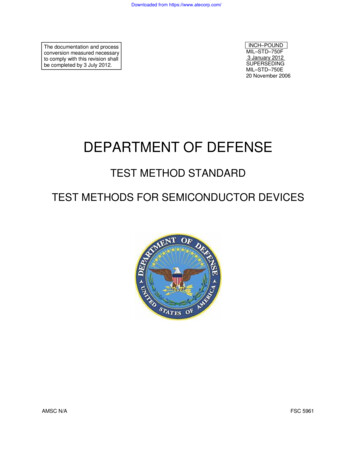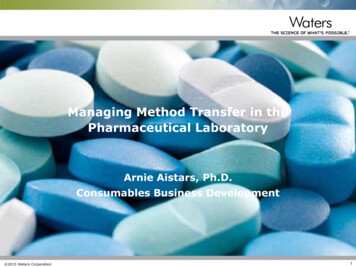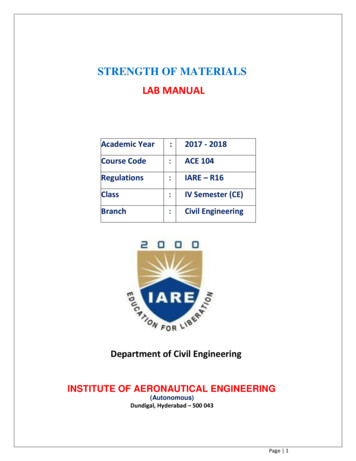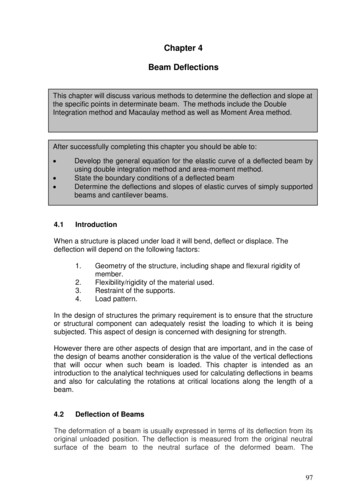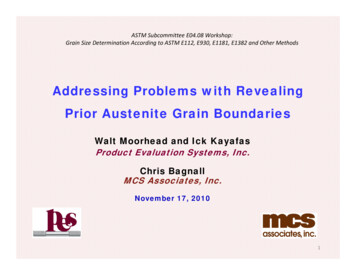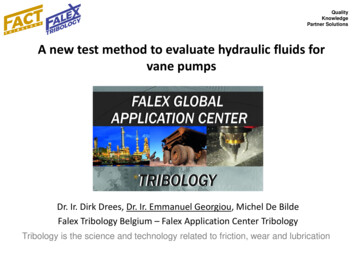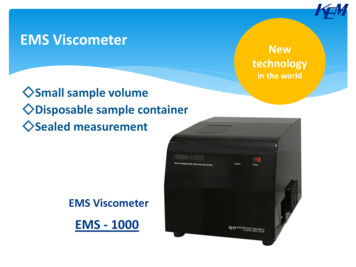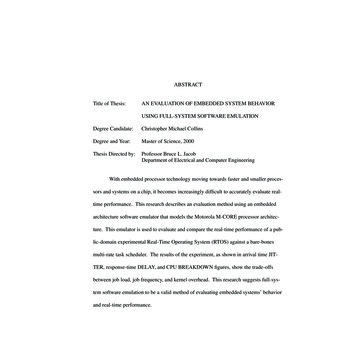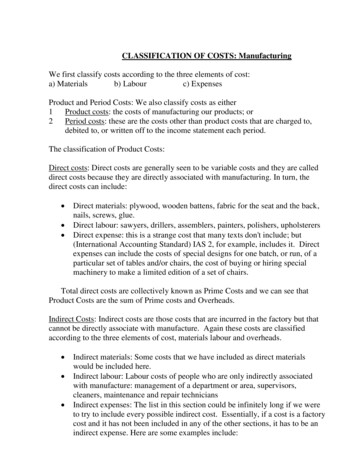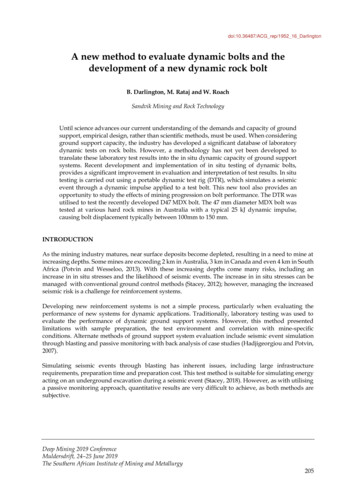
Transcription
doi:10.36487/ACG rep/1952 16 DarlingtonA new method to evaluate dynamic bolts and thedevelopment of a new dynamic rock boltB. Darlington, M. Rataj and W. RoachSandvik Mining and Rock TechnologyUntil science advances our current understanding of the demands and capacity of groundsupport, empirical design, rather than scientific methods, must be used. When consideringground support capacity, the industry has developed a significant database of laboratorydynamic tests on rock bolts. However, a methodology has not yet been developed totranslate these laboratory test results into the in situ dynamic capacity of ground supportsystems. Recent development and implementation of in situ testing of dynamic bolts,provides a significant improvement in evaluation and interpretation of test results. In situtesting is carried out using a portable dynamic test rig (DTR), which simulates a seismicevent through a dynamic impulse applied to a test bolt. This new tool also provides anopportunity to study the effects of mining progression on bolt performance. The DTR wasutilised to test the recently developed D47 MDX bolt. The 47 mm diameter MDX bolt wastested at various hard rock mines in Australia with a typical 25 kJ dynamic impulse,causing bolt displacement typically between 100mm to 150 mm.INTRODUCTIONAs the mining industry matures, near surface deposits become depleted, resulting in a need to mine atincreasing depths. Some mines are exceeding 2 km in Australia, 3 km in Canada and even 4 km in SouthAfrica (Potvin and Wesseloo, 2013). With these increasing depths come many risks, including anincrease in in situ stresses and the likelihood of seismic events. The increase in in situ stresses can bemanaged with conventional ground control methods (Stacey, 2012); however, managing the increasedseismic risk is a challenge for reinforcement systems.Developing new reinforcement systems is not a simple process, particularly when evaluating theperformance of new systems for dynamic applications. Traditionally, laboratory testing was used toevaluate the performance of dynamic ground support systems. However, this method presentedlimitations with sample preparation, the test environment and correlation with mine-specificconditions. Alternate methods of ground support system evaluation include seismic event simulationthrough blasting and passive monitoring with back analysis of case studies (Hadjigeorgiou and Potvin,2007).Simulating seismic events through blasting has inherent issues, including large infrastructurerequirements, preparation time and preparation cost. This test method is suitable for simulating energyacting on an underground excavation during a seismic event (Stacey, 2018). However, as with utilisinga passive monitoring approach, quantitative results are very difficult to achieve, as both methods aresubjective.Deep Mining 2019 ConferenceMuldersdrift, 24–25 June 2019The Southern African Institute of Mining and Metallurgy205
Unlike blasting-simulated seismic events, in situ dynamic impact testing does not require largeinfrastructure, and the setup time, test time and cost requirements are minor. In situ dynamic impacttesting has proven to be far more flexible and applicable to many different mines, and reinforcementproducts. Sandvik designed and constructed a portable in situ DTR in 2012, which has been frequentlyused across Australia and Canada.Recently, the DTR was utilised to evaluate the dynamic performance of a new dynamic rock bolt,Sandvik’s Mechanical Dynamic Extra (MDX) bolt. The DTR has proven to be a significant step forwardin evaluating rock bolts by allowing rock bolt testing in a targeted rock mass.DEMAND AND CAPACITY OF GROUND SUPPORTThe explicit demand placed on ground support systems in localised conditions is still largely unknown.Significant investigation has been conducted into this by many researchers; however, typically morequestions are raised rather than answered (Stacey, 2012 and Potvin, 2013). The method to determinetypical demand on ground support elements is an empirical approach, which uses ground conditions,observations and a long list of assumptions (Potvin and Wesseloo, 2013).However, where the exact demand on ground support system is difficult to determine, the capacity ofa specific ground support element is much simpler to establish. This capacity is found through acombination of laboratory/workshop testing and in situ testing. This testing can verify engineeringdesign of ground support elements, and is classically separated into two categories, either static ordynamic capacity.LABORATORY TESTINGLaboratory or workshop testing is widely used, with an increasing number of facilities with capabilitiesto perform both static and dynamic testing. Static testing is performed by applying an increasing loadat a relatively low strain rate (quasi-static) to a ground support element, until either the target load isachieved, or failure/overload of the test specimen occurs.Dynamic testing is performed with similar intentions to determine the dynamic energy that a rock boltcan withstand prior to failure. However, failure definition is either rupture of the rock bolt (tensileoverload), or excessive displacement of the rock bolt. As new laboratory dynamic impact testingfacilities emerge, new methods of loading and data capture are found.Test methods and facilitiesThere are classically two types of static testing employed when assessing rock bolts; axial and shear.Axial testing is the simplest, and most prevalent, which provides insight into the performance of therock bolt displacement with increasing load. Shear testing proves more demanding, and requires ahigher complexity of testing apparatus, and hence there are fewer facilities providing this type oftesting. Although more difficult, shear testing is incredibly important to quantify a rock bolt’s resistanceto shearing rock movement. The shear capacity of a rock bolt is crucial, as loads applied to a rock boltfrom a seismic event are a combination of axial and shear loading.Many dynamic impact testing facilities are now available for testing of ground support systems, whichtest not only individual components, but entire reinforcement systems. These facilities varysignificantly; however, there are two primary methods of dynamic energy application; momentumtransfer and free-fall of a mass onto a plate.The momentum transfer method is utilised by several facilities including the Western Australian Schoolof Mining (WASM) facility (See Figure 1), located in Kalgoorlie Western Australia and the Swerimfacility located in Lulea, Sweden. This method of energy application closely replicates what is thought206
to be the load transfer mechanism when a seismic wave encounters an underground excavation (Playeret al, 2008a).Figure 1. WASM momentum transfer apparatus (Villaescusa et al, 2005)The other common type of dynamic energy application is the free-fall of a mass onto a plate technique,which is employed by the Canmet facility (Ottawa, Canada, Figure 2), the GIG facility (Poland) and theDynamic Impact Tester (DIT) facility of New Concept Mining (South Africa).207
Figure 2. Canmet dynamic testing facility (Marambio et al, 2018)RESULTS DATABASELaboratory test facilities have developed a large database of dynamic impact results from testsperformed over the past several decades. These results are very comprehensive when it comes to resinor cement grouted bolts, as laboratory facilities are ideal for testing the performance of the connectionbetween the yielding element and resin or cement grout. However, when testing friction type bolts, thedatabase is relatively incomplete, due to the limitations associated with sample preparation. The resultsdatabase is readily available, and has been published in many forms, Potvin (2017). See Figure 3 for asummary of a portion of these test result.208
Figure 3. A summary of Laboratory dynamic test results (Potvin, 2017)CORRELATION TO IN SITU PERFORMANCELaboratory facilities utilise two different sample preparation methods; cement aggregate filled steeltubes, or over-cored rock samples assembled within steel tubes. The first method is the most efficientregarding cost and time and is solely utilised by several facilities. This method is ideal for laboratorytesting, as it ensures a constant test medium with controlled properties. Unfortunately, this artificialrock does not represent underground mining, where rock masses vary significantly.209
The major issue with utilising a cement/grout aggregate for laboratory testing develops when testingfriction style bolts, which rely purely on the connection between bolt and “rock” for dynamicperformance. A relatively thin-wall steel pipe filled with cement aggregate (see figure 4) will differ inmany ways to a large section of rock mass. These differences include confinement on the bore hole,surface roughness/friction of the borehole and straightness of the bore-hole.Figure 4. Simulated borehole in this walled steel pipe (Player, 2008b)A thin walled steel pipe filled with concrete will not provide the same confinement to outward forces,such as from a friction bolt or a wedge anchor mechanism. Likewise, the straightness and surfaceroughness of the simulated bore hole will vary from that found in an underground mine.Laboratory testing applies dynamic energy axially to the test specimen, where this is very rarely thecase in underground mines. The loading of a bolt subject to a seismic event is a combination of axial andshear loading, which is a result of the installation angle relative to the rock face and the direction inwhich the energy wave approaches the excavation.IN SITU TESTINGIn contrast to laboratory testing, until recently, very little in situ dynamic testing has been conducted.This is due to the difficulties involved with adapting existing laboratory apparatus to the undergroundenvironment. Where laboratory testing is ideal for benchmark testing, in situ dynamic testing providesinvaluable information on the performance of ground support elements in specific strata conditions.Testing ground support elements in situ offers an opportunity to analyse variations related to testsample installation. These can include; machine differences, operator methods (and errors), orientationto the rock face and, most important, variations in ground conditions. Additional testing benefits of insitu testing include delayed testing, where samples are tested sometime after installation. This testmethod provides insight into the effects of mining progression, localised ground movement andexposure to ground water on the dynamic performance of ground support elements.210
SANDVIK APPARATUS DEVELOPMENTIn 2012, Sandvik identified the need for an in situ testing apparatus and the associated benefits ofproviding this type of testing. Therefore, Sandvik designed and constructed a portable in situ dynamictest rig, capable of being transported to any mine site, and testing any rock bolt in any rock type. Aninitial prototype apparatus was utilised in association with Mikula Geotechnics and Rocktech for theintroduction of the Sandvik Mechanical Dynamic (MD) bolt at Mt Charlotte Gold Mine in 2013 (Carltonet al, 2013). The results from this testing further highlighted the need for a fully functional in situdynamic test rig.The first complete DTR was used between 2013 to 2016 to verify the performance of the Sandvik MDbolt and other rock bolts at 5 sites across Australia. During this test period, several design improvementsincreased both the speed and ease of testing.The DTR apparatus utilises the free-fall of a mass onto a plate energy application technique and canapply dynamic energy up to 38 kJ in a single impact. Typically, test regimes apply single dynamicimpacts to each test bolt; however, multiple impacts on one bolt are possible, and planning is underwayfor future testing. The applied energy is easily modified, similar to laboratory facilities, by adjusting thedrop mass or drop height; however, the impact velocity is typically maintained between 5.2 m/s to 5.7m/s.The DTR, like any laboratory facility, is capable of both non-destructive and destructive dynamictesting. In both testing scenarios the DTR captures the load applied to the bolt and displacement of thebolt. A piezoelectric load cell measures the load applied to the bolt and accelerometer data allowscalculation of bolt displacement. Both sensors record at 25 kHz and link directly to a control box, whichalso activates the release mechanism. The drop mass is released using a remotely operated control, witha maximum safe release distance of 50 m.The method to connect the DTR to the rock bolt is important, as this minimises the time required to testeach rock bolt and contains the sensors. The current embodiment (See Figure 5) is in the form of apatented two-part claw assembly, which contains domed connections top and bottom. These domedconnections allow for variations in bolt installation angle (Up to 10 from vertical). In this configuration,the DTR can apply not only axial loads, but also a portion of shear and bending loads, which closerrepresents loading during a seismic event. Typically, bolt installation angle is limited to 5 ; however, astudy on the influence of bolt installation angle to dynamic performance is planned for future testing.211
Figure 5. Sandvik Dynamic Test RigUTILISATION TO TEST SANDVIK MDX BOLT PERFORMANCEFrom 2016, the Sandvik DTR assisted in the development of Sandvik’s new dynamic rock bolt, theMechanical Dynamic Extra (MDX) bolt. The MDX bolt was developed to provide more consistent in situdynamic performance when subjected to dynamic energy in excess of 22 kJ.The design platform of the MDX bolt comprises a 47 mm diameter friction bolt tube and wedgeexpansion system similar to the MD bolt (See Figure 6 and Figure 7). The key differences between theMD and MDX bolts are the wedge assembly and the load transfer mechanisms. The wedge assemblydesign review increased the maximum tube expansion to 60 mm, which has a dual advantage. The MDXbolt is suitable for a greater range of ground condition and this wedge system assists in dissipatingdynamic energy.Figure 6. The Sandvik Mechanical Dynamic (MD) bolt212
Figure 7. The Sandvik Mechanical Dynamic Extra (MDX) boltThe other, and more important, design change is the load transfer mechanism. Where the MD boltutilised both the friction tube and the rebar to absorb strata load, the MDX bolt relies solely on the rebarto absorb both static and dynamic loads. This change allows for development of higher anchorageforces, removes the MDX bolt’s reliance on friction to dissipate dynamic energy and is key to thesuperior dynamic performance of the MDX bolt.MDX in situ testing resultIn order to evaluate the dynamic performance of the new MDX design, a thorough in situ dynamicimpact testing regime was conducted at Telfer Gold Mine (Darlington at al, 2018). This testing regimeincluded a series of single dynamic impacts on 26 prototype MDX bolts, with pass criteria ofwithstanding 25 kJ and limiting displacement to 200 mm.The dynamic testing began at a qualification level (Four bolts tested at 22.1 kJ), which assisted ingauging the MDX bolt performance close to the upper limit of the MD bolt. The loading then progressedto a specification level (24 kJ to 27 kJ), which was the target for the test, with five bolts initially tested atthis energy level. As these bolts all performed extremely well, with displacements between 97 mm to128 mm, the dynamic energy was increased to a high level (28 kJ to 30.5 kJ) with nine bolts tested. Eightof these bolts withstood the dynamic impact with displacements limited to a range of 115 mm to 153mm, with one bolt overloaded. Following the overloaded bolt, the input energy was decreased to thespecification level range, with the final eight bolts withstanding the impact energy, resulting in adisplacement range of 113 mm to 138 mm.Following this initial testing, the MDX bolt has undergone dynamic testing at six additional sites withground conditions ranging from competent (UCS of 250 MPa) to very poor ground (UCS of 50 MPa).Nevertheless, even with this variation in ground conditions, the results for the MDX have shownminimal variation. Figure 8 shows the summary of MDX bolts subjected to dynamic loading, withoverloaded bolts shown on the right of the graph.213
MDX Bolt Dynamic Performance30Absorbed Energy (kJ)2010Overloaded bolts0050100150200250300Displacement (mm)MDX Mine E-UCS 240 MPaMDX Mine H-UCS 50 MPaMDX Mine K-UCS 200 MPaMDX Mine F-UCS 127 MPaMDX Mine I-UCS 215 MPaMDX Mine G-UCS 100 MPaMDX Mine J-UCS 192 MPaFigure 8. Absorbed energy Vs displacement summary for all MDX bolt testsCONCLUSIONCurrently, there is a variety of laboratory dynamic testing facilities available for benchmarking dynamicground reinforcement products. These facilities have established a database of reinforcementperformance under dynamic loading conditions. However, it is difficult to correlate these results tounderground conditions.The Sandvik DTR expands the capabilities of dynamic testing, taking a significant step forward toprovide dynamic performance data for ground reinforcement products in underground mineconditions. This method of testing is not only quick and cost effective, it also opens avenues forevaluating the influence of mining progression on ground reinforcement systems. The planned delayedtesting at a specific time after installation will provide additional insights for further improvements ofground reinforcement systems.The Sandvik DTR was successfully utilised as a development tool for the new MDX bolt, evaluating theperformance of this bolt in seven different rock types. The performance of the MDX bolt remainsconsistent, with a displacement range of 105 mm to 161 mm, while absorbing dynamic energy between25 kJ and 30 kJ.214
REFERENCESCarlton, R., Mikula, P., Darlington, B. 2013. In situ dynamic drop testing of the MD bolt at Mt CharlotteGold Mine. Proceedings of the Seventh International Symposium on Ground Support in Mining andUnderground Construction 2013. Potvin, Y. and Brady, B. (eds). Australian Centre forGeomechanics, Perth. pp. 207-219.Darlington, B., Rataj, M., Balog, G., Barnett, B. 2018. Development of the MDX Bolt and in situ dynamictesting at Telfer Gold Mine. Proceedings of the 3rd international conference on Rock Dynamics andApplications (RocDyn-3) 2018. Li, C., Li, X. and Zhang, Z. (eds). CRC Press, Leiden. pp. 403-408.Hadjigeorgiou, J., Potvin, Y. 2007 .Overview of Dynamic testing of Ground Support. Proceeding of the 4thInternational Seminar on Deep and high stress mining 2007. Y Potvin (eds). Australian Centre forGeomechanics, Perth, pp. 349-371.Li, C.C., Stjern, G., Myrvang, A. 2014. A review on the performance of conventional and energyabsorbing rockbolts. Journal of Rock Mechanics and Geotechnical Engineering, 6 (2014), 315-327.Marambio, E., Vallejos, JA., Burgos, L., Gonzalez, C., Castro, L., Saure, JP,. Urzua, J. 2018. Numericalmodelling of dynamic testing for rock reinforcement used in underground excavations.Proceeding of the 4th International symposium on Block and Sublevel Caving 2018. Y Potvin (eds).Australian Centre for Geomechanics, Perth.Player, J., Villaescusa, E., Thompson, A. 2008. An Examination of Dynamic Test Facilities. AustralianMining Technology Conference 2008.Player, J., Thompson, A., Villaescusa, E. 2008. Dynamic Testing of Reinforcing Systems. Proceeding of the6th International Symposium on Ground Support in Mining and Civil Engineering Construction 2008.SAIMM, SANIRE and ISRM. pp. 597-622.Potvin, Y., Wesseloo, J. 2013. Towards an understanding of dynamic demand on ground support.Proceedings of the Seventh International Symposium on Ground Support in Mining and UndergroundConstruction 2013. Potvin, Y. and Brady, B. (eds). Australian Centre for Geomechanics, Perth. pp.287-304.Potvin, Y. 2017. The need for new technology to optimise the engineering of ground support systems inunderground mines. Proceedings of the First International conference on Ground Mining Technology2017. Potvin, Y. and Hudyma, M (eds). Australian Centre for Geomechanics, Perth.Shirzadegan, S., Nordlund, E., Zhang, (2016). In situ dynamic testing of rock support at LKABKiirunavaara mine. Proceedings of the 8th International Symposium on Ground Support in Mining andUnderground Construction 2016. Nordlund, E., Jones, T.H., and Eitzenberger, A. (eds). Luleauniversity of Technology, Sweden. pp. 515-526.Shirzadegan, S., Nordlund, E., Zhang, P. 2016. Large Scale Dynamic Testing of Rock Support System atKiirunavaara Underground Mine. Rock Mechanics and Rock Engineering (2016). 49:2773.Stacey, T. 2012 .A philosophical view on the testing of rock support for rockburst conditions. Journal ofthe Southern African Institute of Mining and Metallurgy, vol. ISSN 2411-9717, 112, no. 8, pp. 703-710.Stacey, T. 2018. A personal review of South African rockburst research, experience and lessons learnt.Proceedings of the 4th Australasian Ground Control in Mining Conference (AusRock 2018). TheAustralasian Institute of Mining and Metallurgy. pp. 5-16.215
Villaescusa, E., Thompson, A., Player, J. 2005. Dynamic Testing of Rock Reinforcement Systems.Australian Mining Technology Conference 2005.Bradley DarlingtonR&D Engineer – BoltingSandvik Mining and Rock TechnologyBradley Darlington is an R&D design Engineer at Sandvik Mining and Rock Technology. He completedhis Bachelor of Engineering (Mechanical) in 2009, and has worked in Sandvik’s Bolting division for thepast 7 years. Over this time, he has been involved with designing and implementing new products intothe ground support market, and managed the design, development and use of the first ever in-situdynamic test rig.216
Dynamic Impact Tester (DIT) facility of New Concept Mining (South Africa). 208 Figure 2. Canmet dynamic testing facility (Marambio et al, 2018) RESULTS DATABASE . friction style bolts, which rely purely on the connection between bolt and "rock" for dynamic performance. A relatively thin-wall steel pipe filled with cement aggregate (see .
